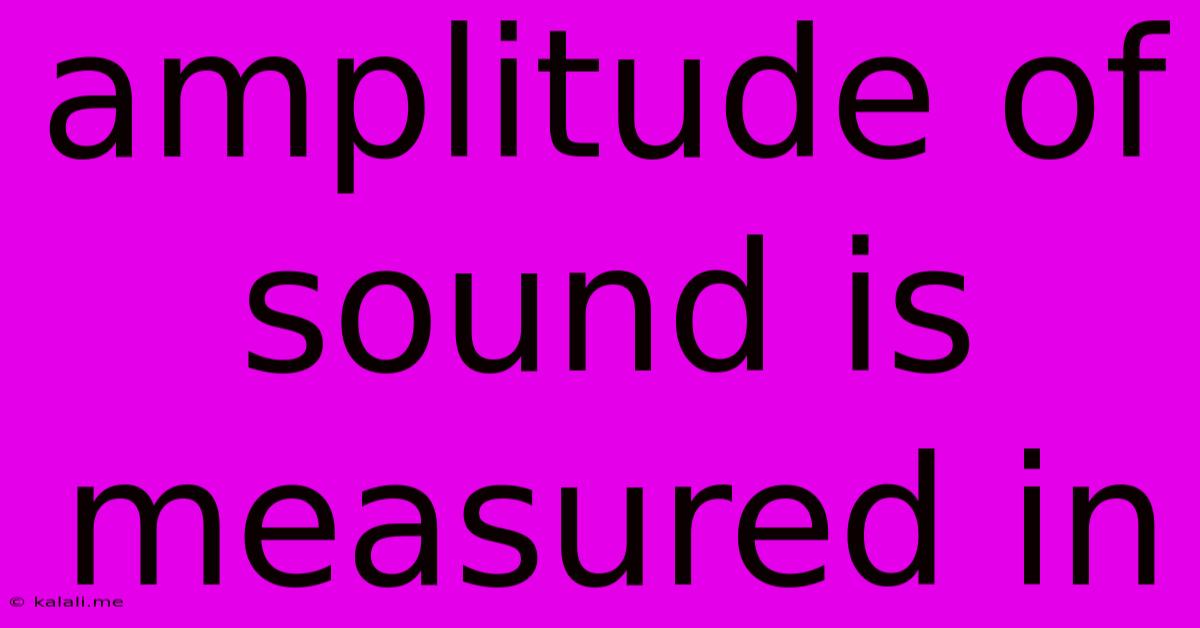Amplitude Of Sound Is Measured In
Kalali
Jun 15, 2025 · 3 min read

Table of Contents
Amplitude of Sound: Measured in Decibels and Beyond
Sound, a fundamental aspect of our daily lives, is a form of energy that travels as waves. Understanding the properties of these waves, particularly their amplitude, is crucial for comprehending how we perceive and measure sound. This article will explore how the amplitude of sound is measured, focusing primarily on decibels, while also touching upon related concepts.
What is Sound Amplitude?
Simply put, the amplitude of a sound wave refers to its intensity or strength. A larger amplitude corresponds to a louder sound, while a smaller amplitude signifies a quieter sound. Think of it like this: a small ripple in a pond has low amplitude, whereas a large wave crashing on the shore has high amplitude. This intensity is directly related to the amount of energy the sound wave carries.
The Decibel Scale: Measuring Sound Intensity
The most common unit for measuring sound amplitude is the decibel (dB). The decibel scale is a logarithmic scale, meaning that a change of 10 dB represents a tenfold change in sound intensity. This scale is preferred because the human ear perceives loudness logarithmically; a small change in decibels can translate to a significant perceived difference in loudness.
Here's a breakdown of the decibel scale and typical sound levels:
- 0 dB: The threshold of human hearing – the quietest sound a person with normal hearing can detect.
- 20-40 dB: Quiet sounds like a whisper or rustling leaves.
- 40-60 dB: Normal conversation level.
- 60-70 dB: Moderate traffic noise.
- 70-90 dB: Loud sounds like a vacuum cleaner or a lawnmower. Prolonged exposure can cause hearing damage.
- 90-110 dB: Very loud sounds like a power tool or a concert. Hearing damage is likely with prolonged exposure.
- 110 dB and above: Extremely loud sounds like a jet engine or a rock concert. Immediate and permanent hearing damage is possible.
Beyond Decibels: Other Related Measures
While decibels are the primary unit for measuring sound intensity (amplitude), other related measures exist and are often used in specific contexts:
- Sound Pressure Level (SPL): This measures the effective pressure of a sound wave. It's often expressed in decibels (dB SPL).
- Sound Intensity: This refers to the power carried by the sound wave per unit area. It's typically measured in watts per square meter (W/m²).
Factors Affecting Sound Amplitude
Several factors influence the amplitude of a sound wave:
- Distance from the source: Sound intensity decreases with distance from the source.
- Power of the source: A more powerful sound source produces sound waves with greater amplitude.
- Medium of propagation: The medium through which the sound travels (air, water, etc.) affects the amplitude.
- Absorption and reflection: Obstacles in the sound path can absorb or reflect sound waves, altering their amplitude.
Conclusion:
Understanding the amplitude of sound is crucial in many fields, including acoustics, audio engineering, and environmental science. The decibel scale provides a practical and relatable way to quantify sound intensity, allowing us to understand and manage sound levels effectively to protect our hearing and control the acoustic environment. While decibels are the most common measure, other related concepts such as SPL and sound intensity provide a more nuanced understanding of sound's physical properties.
Latest Posts
Latest Posts
-
What Is The Current Flowing Through The 6 Ohm Resistor
Jun 15, 2025
-
Colorless Liquid Hydrocarbon Of The Alkane Series 7
Jun 15, 2025
-
What Are The Factor Pairs Of 54
Jun 15, 2025
-
Which Compound Contains Both Sigma And Pi Bonds
Jun 15, 2025
-
How To Find The Radius Of A Triangle
Jun 15, 2025
Related Post
Thank you for visiting our website which covers about Amplitude Of Sound Is Measured In . We hope the information provided has been useful to you. Feel free to contact us if you have any questions or need further assistance. See you next time and don't miss to bookmark.